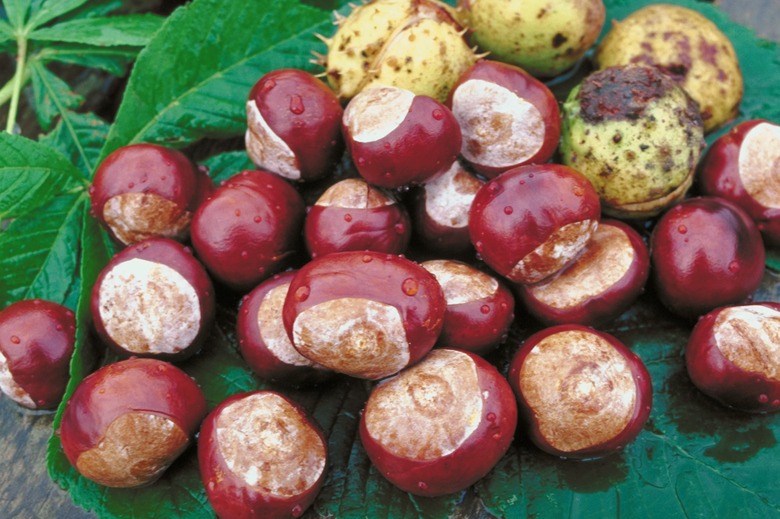What Is The Difference Between A Horse Chestnut & A Chestnut Tree?
The tree with the common name "horse chestnut" isn't a chestnut tree at all. Its botanical name is Aesculus hippocastanum, and it belongs to the Sapindaceae family, which also includes maples. The native American chestnut tree, which is nearly extinct in the United States because of a fungal disease, is Castanea dentata, a member of the Fagaceae, or beech, family. A third tree, the Ohio buckeye (Aesculus glabra), also produces nuts that are sometimes called horse chestnuts.
Habit
Step 1
The horse chestnut tree is the largest of the three, reaching more than 100 feet tall in a dome shape. In spring, it produces fat, fragrant, foot-long panicles of white flowers with red dots at their base. The Ohio buckeye grows to 50 feet tall and produces unscented pale-yellow flower clusters in early June. The American chestnut tree reaches about 40 feet tall and blooms in June with 8-inch-long catkins of fragrant, creamy-white flowers.
- The tree with the common name "horse chestnut" isn't a chestnut tree at all.
- The American chestnut tree reaches about 40 feet tall and blooms in June with 8-inch-long catkins of fragrant, creamy-white flowers.
Leaves
Step 1
All three trees are deciduous. The American chestnut has shiny, yellow-green leaves with curving teeth along the edges that turn yellow in the fall. The seven leaflets of the horse chestnut are larger and coarser and emerge a light green, turning dark green as they mature. The finely toothed leaves of the Ohio buckeye are narrow and medium green. They turn gold and orange in the fall.
Nuts
Step 1
The American chestnut produces sweet, edible nuts inside spiny burrs containing two or three teardrop-shaped seeds. Ohio buckeye nuts ripen in late summer and early fall inside thick, knobby husks. There is usually only one shiny, brown nut inside each. Horse chestnuts grow inside thick, green, spiny husks that can contain up to four nuts. Neither buckeyes nor horse chestnuts are edible; they contain dangerous toxins.
- All three trees are deciduous.
- The American chestnut has shiny, yellow-green leaves with curving teeth along the edges that turn yellow in the fall.
Culture
Step 1
Plant horse chestnut in full or part sun in well-drained soil with regular moisture. It isn't fussy about soil type and thrives in U.S. Department of Agriculture plant hardiness zones 4 through 8. American chestnut, which thrives in USDA zones 5 through 8, prefers full sun and moist, well-drained soil. Ohio buckeye grows in USDA zones 3 through 7 in full or part sun and does well in moist, fertile soil. Trees in the genus Aesculus have taproots and are not easily transplanted.
Habitat
Step 1
Horse chestnut is native to Southeast Europe, where it grows in mixed forests. The American chestnut is native to the Eastern U.S. hardwood forest. The Ohio buckeye is native to the forests of Ohio, Michigan, Missouri, northern Iowa and Illinois, and east to western Pennsylvania.
- Plant horse chestnut in full or part sun in well-drained soil with regular moisture.
- Ohio buckeye grows in USDA zones 3 through 7 in full or part sun and does well in moist, fertile soil.
Lore
Step 1
In Britain and Ireland, horse chestnuts are attached to strings and used for a children's game called conkers. In her diary, Anne Frank mentions the horse chestnut tree in the center of Amsterdam, which stood until 2010. The buckeye got its name from Native Americans, who decided it resembled the eye of a deer. Since colonial times, buckeyes and horse chestnuts have been carried as good luck charms.
